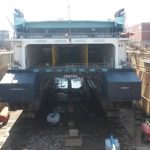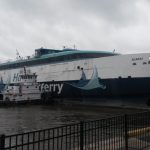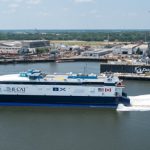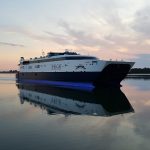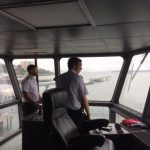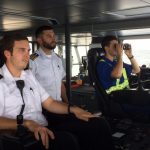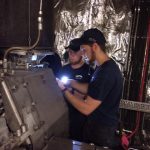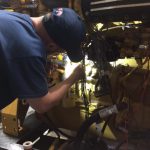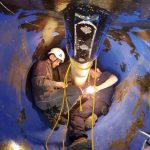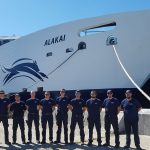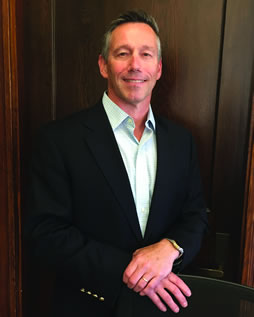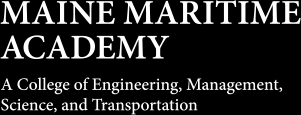Archive for December, 2018
Eight Bells
Class Notes
Alumni News
Campus Currents
CAT on the Run
If you’ve visited Portland, Maine, lately, or glanced out to sea from many points along Maine’s midcoast, you may have seen the sleek catamaran passenger ferry recently acquired for the revived service between Nova Scotia and Maine.
Since the spring of 2016, the HSV Alakai, commonly known and branded as the CAT, has carried nearly 135,000 passengers between Portland and Yarmouth, offering approximately 120 daily, round-trip voyages per season from early June to mid-October.
The CAT has many unique attributes, most notably her top speed of 45 knots, classifying her as one of the fastest passenger vessels operating in North America. Another, which may not be so commonly known, is that she is home to nine Maine Maritime Academy alumni, serving in a range of crew billets and collectively accounting for more than half of her marine department. Each MMA alum has his or her own story of the path that led to Alakai, and though all are different, they are equally interesting, much like the story of Alakai herself.
STOP & GO
Alakai was launched from Austal, USA (Mobile, Alabama) in April 2007. She was purpose-built to serve as an inter-island roll-on/roll-off passenger ferry between Oahu and Maui, deploying on her maiden Hawaiian voyage in August of the same year. The Hawaiian service, however, was short-lived, and operations were discontinued in 2009 due to various challenges, and both Alakai and her sister ship, Huakai, came under the ownership of the U.S. Maritime Administration (MARAD).
Both were assigned a deployment to Haiti as part of the earthquake relief effort in 2010. In 2012, they were transferred from MARAD to the U.S. Navy. Alakai would then be known as the USNS Puerto Rico.
For the next several years, the Puerto Rico remained in lay-up status in Philadelphia, Pennsylvania. The Navy kept the vessel manned with a reduced crew, sourcing personnel through Seaward Services, Inc., based in New Albany, Indiana.
SET TO SERVE AGAIN
In early 2016, Bay Ferries Limited (BFL), a Canadian-based company and original operators of the former CAT ferry service from Portland and Bar Harbor, was in search of a vessel that would satisfy a new contract with the Province of Nova Scotia, providing passenger service between Yarmouth and Maine. BFL had successfully operated multiple high-speed ferries from Nova Scotia to Maine from 1997 to 2009, eventually discontinuing the seasonal route due to high fuel costs and the economic downturn.
After extensive processes and discussions, the U.S. Navy and BFL entered into a lease agreement that would utilize Alakai to offer the ferry service. The vessel, capable of carrying some 750 passengers and 200 cars, would operate between the ports of Portland and Yarmouth at a service speed of 35 knots.
Reviving the ferry service had the support of the Province of Nova Scotia along with businesses and individuals in Maine, including Sen. Angus King and Rep. Chellie Pingree, who were instrumental in its renewal, BFL was optimistic it could once again provide reliable ferry service. This left the company in search of a vessel fit for the task.
The Alakai was towed to Detyens Shipyard in North Charleston, South Carolina, in April 2016, where it was refitted, recertified, and reclassed, undergoing extensive repair and overhaul over eight short weeks in preparation for its service charter in the Gulf of Maine.

The CAT enters Yarmouth harbor during the first days of her inaugural season in 2016.
Since Alakai remained under U.S. flag, the officers and crew were required to be American citizens holding U.S. Coast Guard credentials. Seaward Services continued to provide crewing requirements to BFL, but there were fewer than a half dozen employees inherited with the ship. This left Seaward Services facing the challenge of sourcing officers and crew with a tight deadline.
As all of the newly hired crew members would be strangers to the vessel, and most to the fast-ferry industry, there was a push to get the billets filled quickly to allow for a few weeks of ship familiarization and to complete the type-rating process. To become type-rated, every officer or prospective officer must complete a series of exams that evaluate safety, high-speed code, vessel particulars, damage control procedures, mechanical systems, and crowd and crisis management. The exams, along with proof of the required day and night trips into each specified port of the route, are submitted to the U.S. Coast Guard for a supplemental qualification to each officer’s STCW and Merchant Mariner’s Credential.
At the start of her inaugural season in June of 2016, the Alakai’s marine crew of 14 included four Maine Maritime alumni.
Andrew Parker ’04, who was originally hired as the Chief Mate, was promoted to Captain midway through the first season and has been at the helm through each season since.
“It’s amazing to maneuver a vessel with such a large power-to-weight ratio,” he says. “These are the sports cars of the maritime industry.”
Parker joined Alakai after several years on drill ships and, previously, tankers. “Working with so many of my fellow alumni has been a pleasure, and it gives me a great sense of pride to see the caliber of mariners MMA produces.”
INAUGURAL SEASON
Alakai’s first season was a success due to perseverance. Many believed getting the ship ready in time was not possible given her distressed condition, while others were skeptical there was time for a marketing campaign that would yield adequate ticket sales. But as the company and crew faced challenge after challenge, they continually worked together to overcome obstacles, and met financial goals without any mechanical downtime.
Casey Hawkins ’11 is First Assistant on the CAT. He joined the vessel just after she was towed to South Carolina before the first season, returning to a seafaring career after several years working in a biomass power plant in Jonesboro, Maine.
“Working aboard the CAT is the most stressful and the most rewarding job of my career,” he said. “The great crew and the changing dynamics each day bring an experience like no other.”
CAT IS A SNOWBIRD
Due to Maine’s winter weather and decrease in tourism traffic, Alakai returns to Detyens Shipyard each winter for maintenance, repair, and improvement. Staff is reduced to six marine department crew members, typically working a 28-day-on/28-day-off schedule.
Alakai’s first full off-season period included a comprehensive replacement of every cylinder head on her four MTU 20V8000 series engines due to an improved design implemented by the manufacturer. Eighty cylinders total, it required nearly two months to complete.
There was a great deal of anticipation entering 2017, but then an engine failure early in the season presented a major challenge. With repairs not possible during operations, the decision was made to finish the season with the remaining three engines and alter the schedule to accommodate accordingly.
Although some perceived this as a heavy blow to the service, the majority of passengers, employees, and the public who witnessed the resiliency of BFL and the crew overcome this enormous challenge gave then confidence the CAT would prevail. And it did.
MORE MMA ABOARD
After a six-month rebuild to the damaged engine, which included a total crankshaft replacement, Alakai underwent an intensive sea trial at full power capacity and was ready to embark on her third season in the Gulf of Maine.
This year’s operation brought aboard two Maine Maritime cadets, as well as three alumni from the class of 2018, less than two weeks after graduation.
“My experience onboard Alakai provided great experience,” says Madison Barry, class of 2020, who completed her 90-day cadet shipping program on Alakai. “I was able to grow as a prospective professional because of the teaching and leadership skills I learned from the crew and officers.” Some of her daily routine included navigational watch, line handling, loading and off-loading vehicles, and assisting in creating an inviting passenger experience.

All nine of the CAT’s MMA alumni. From L to R, AB Mark Harper ’18, QMED/Asst. Eng Matt Violette ’18, AB Truman Slocum ’18, AB John O’Keefe ’09, 2/M Malcolm Faux ’15, C/M Will Cunningham ’12, Capt. Andrew Parker ’04, C/E Jacob Turgeon ’02, 1A/E Casey Hawkins ’11.
Trenton Bouchard, also class of ’20, joined Alakai as an engine cadet. Bouchard was exposed to an array of operations and troubleshooting scenarios and was able to work closely with the vessels’ electronics technician, as well as the engineering officers. “During my cadet shipping experience, I was warmly welcomed by the crew, many of whom are Maine Maritime alumni.
“While onboard, I had the opportunity to apply the skills learned in the classroom to real-world situations. And I was provided freedom to demonstrate my abilities, as well as given guidance from the crew to expand my skill set.”
Matthew Violette and Truman Slocum, both 2018 MMA grads, also joined Alakai. “It’s hard to believe I was able to get a job so quickly after finishing school,” says Violette, “and so close to home (Portland) doing what my license allows me to do. It feels like a good start to my career.”
Other MMA alumni include AB Mark Harper ’18, AB John O’Keefe ’09, Second Mate Malcolm Faux ’15, and Chief Mate Will Cunningham ’12, who served during the 2018 season, in which Alakai carried more than 50,000 passengers.
BAR HARBOR POTENTIAL
In recent months, BFL has made significant progress in the potential reintroduction of the fast-ferry route between Yarmouth and Bar Harbor. Alakai would fulfill this service, reducing the duration of a round trip to about 3.5 hours in comparison to its current route to Portland (5.5-6 hours).
Transiting from Bar Harbor would allow the ferry to take advantage of a large volume of tourism traffic flowing between Downeast Maine and Southwest Nova Scotia, as well as reduce fuel consumption, a key concern to BFL, which has enrolled in Green Marine, an aggressive certification program that evaluates a company’s action to reduce its environmental impact. If the shift to Bar Harbor takes place, it is hoped to be in time for the 2019 season.█
- Resurrection of Alakai begins.
- Alakai as Bay Ferries assumed operation in April 2016. It was towed from Philadelphia to Charleston and entered service eight weeks later.
- The Alakai departs Detyens Shipyard in North Charleston, South Carolina after a mere eight weeks of repair, renewal and recertification to begin service from Yarmouth, Nova Scotia to Portland, Maine.
- The CAT enters Yarmouth, Harbor during the first days of her inaugural season in 2016.
- Capt. Andrew Parker ‘04 and 2/M Malcolm Faux ’15 maneuvering out of Portland Harbor.
- AB Mark Harper ’18 assumes lookout as 2/M Malcolm Faux and Capt. Andrew Parker navigate the ship out of Portland, Maine.
- Engine cadet Trenton Bouchard ’20 assists QMED Matt Violette ’18 on a main engine turbo charger.
- QMED/Assistant Engineer Matt Violette ’18 troubleshoots a diesel gen set while underway.
- One of the Alakai’s main engines inverted to remove and replace the crankshaft after a bearing failure. She is powered by four MTU 20V8000 diesels rated at 11,000 hp each.
- Chief Engineer Jacob Turgeon and Rolls Royce Field Representative inspecting one of four of Alakai’s impeller shafts.
- All nine of the CAT’s MMA alumni. From left to right: AB Mark Harper ’18, QMED/Asst. Eng Matt Violette ’18, AB Truman Slocum ’18, AB John O’Keefe ’09, 2/M Malcolm Faux ’15, C/M Will Cunningham ’12, Capt. Andrew Parker ’04, C/E Jacob Turgeon ’02, 1A/E Casey Hawkins ‘11.
Photos: courtesy of Alakai crew
HELLO!!Homecoming: It’s Personal
Frank Tepedino has seen a lot since graduating from MMA in 1958 as an engineer.
He served as an engineering officer in the U.S. Navy; third assistant engineer in the Merchant Marine; came ashore to earn a degree in industrial management and study finance in graduate school; worked for Lockheed Shipbuilding, Electric Boat, and Pacific Power & Light; and, following graduation from the University of San Diego Law School, worked as House Counsel for FMC Corp. Later he founded and was CEO of The Condor Group, a consulting and executive training firm from which he retired a few years ago.
But on Thursday, September 27, the beginning of Homecoming 2018, he looked about, walking across the early fall-green lawn behind Dismukes Hall, MUGs hurrying by, and was summarily impressed by all that has changed at MMA.
“It was a different school then than it is now,” he said. “The student makeup is different. The facilities, instructors’ roles and qualifications, and the academy’s purpose are also different.”
“We shoveled coal at 1:00 A.M. into the academy’s furnaces,” he said as he pointed to Dismukes. “We drove the garbage to the landfill, cleaned and polished the decks in the buildings, painted bulkheads…”
As he crossed the street with his wife, Carmen, he looked to Leavitt Hall and noted his dorm room was in a space now occupied by President Brennan’s office. A few minutes later, he entered the lunch line at the recently renovated dining hall and topped a new porcelain plate with fresh salad.
“We had metal plates, and you might get a dollop of ice cream atop your mashed potatoes,” he quipped.
COMING BACK, GIVING BACK
Tepedino is among some 200-plus alumni who returned to MMA for this year’s Homecoming activities, ranging from a panel discussion with students to sports events, receptions, reunions, waterfront activities, tours and classes, memorial and honor services.
It was incredible. Here’s to all our shipmates, near and far. We hope you make your way back to the academy for the next one.
Events included three days that brought alumni together to reminisce, celebrate life and career, and explore the changes that have taken place at the college. And in their own special way, many took the opportunity to give back something to MMA.
LISTENING & LEARNING
The first event Thursday afternoon was an alumni panel discussion, “Reeling in the Years,” offered to students in Delano Auditorium. Five alumni representing 60 years of perspective, from the class of ’58 (with Tepedino as panelist) to the class of 2003, shared their academic and professional experiences, offering insight on career planning and pursuits.
Among the questions the panel addressed: What was the one thing you wished you had done or participated in while a student at MMA?
“It was a mad rush from day one here at MMA until the last bell rang,” said Tepedino. “Perhaps I should have concentrated harder on some of the subjects offered. So I would admonish students to squeeze out all of the juice with your time here.
“I don’t have any regrets from my time at MMA. It set me on my course for life.”
There were discussions regarding job interviews, work/life balance, lessons learned from accomplishment and failure, and more.
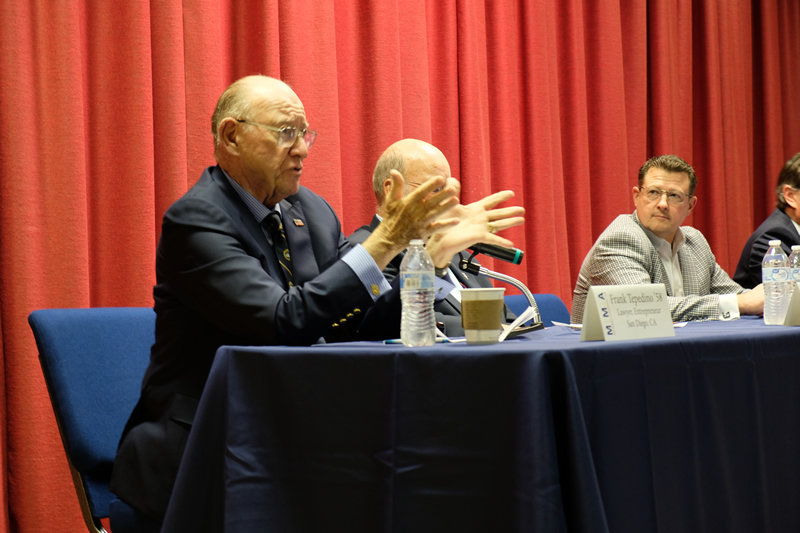
Tepedino offers advice to students during an alumni panel.
PERSONAL MISSION
The following morning, alumni were invited to the 7:00 A.M. regiment formation. They attended their choice of classes throughout the day, teed up for golf at the Alumni & Friends Golf Classic, and some made sure they got first dibs on items at the campus bookstore.
Tepedino had his own mission. At 9:00 A.M., along with classmate Everett Cooper, who retired as a senior executive for Sea Land, a Maersk company, he met at the Waypoint with John Angelberger, a junior in Marine Engineering Operations and recipient of the Francis J. Tepedino Regimental Scholarship Fund, started in 2000.
The discussion began with questions about Angelberger’s coursework, and Tepedino suggested that in addition to his focus on engineering, he should study business and finance whenever there is an opportunity. “Even if you’re an engineer on a ship you’ll be dealing with contractors, and you will be ahead of the game if you have an understanding of contracts and law,” said Tepedino.
More advice. Several sea stories. Four students sitting nearby and listening were invited to pull up a chair and join the discussion.

Tepedino with the recipient, John Angelberger, of a regimental scholarship he created in 2000. Other students pull up a chair to listen while Tepedino’s classmate, Everett Cooper, holds court.
As the session came to an end, Tepedino said, “I have one requirement, John. When you’re out of here and successful, you have to start a scholarship for students who are struggling, as I was.
“There was no way I would have attended MMA if a father of a friend of mine hadn’t written a check to help pay for my first year of college. My dad was a shoeshine boy from Italy. The check from that guy opened the door for me and my life.”
HONORS
Friday evening’s events began with an alumni reception at the ABS Center for Engineering and Science. Within a half hour, the reception area was shoulder-to-shoulder with alumni and guests. There were shout-outs when classmates recognized one another, firm handshakes, and hugs. Revelry.
The alumni dinner followed at the Alexander Field House. The highlight was the presentation of alumni awards.
This year’s awards included a new category, the Humanitarian Award, presented to Capt. Paul Jacobs ’58 for his epic humanitarian achievement during the fall of Saigon in 1975 that resulted in the rescue of more than 30,000 lives. (View a brief video profile of Jacobs at youtu.be/CUiLjY53nH4). The 2018 Wall of Honor inductees were Rear Adm. Thomas K. Shannon ’82 and Rear Adm. Bryan P. Cutchen ’83, and the Outstanding Alumnus recipient was Eugene H. “Gene” Spinazola ’61 (posthumously).

REMEMBRANCE
Saturday morning, before the big crowd assembled for tailgating, tall tales, and the football game, there was a pause.
A small group quietly gathered to dedicate a new memorial plaza behind the Alfond Student Center that pays tribute to MMA alumni who have perished in the line of duty and those lost at sea. The memorial consists of a new granite monument funded by the class of 1962 with the list of those who have passed over the bar, a bronze plaque donated by the class of 1949, as well as a 3-inch, 50-caliber gun with which early academy classes trained before shipping out to war.
Up the hill, soon thereafter, members of the class of 1958, including Tepedino, family, and MMA community members, gathered before the flagpole for an Eight Bells ceremony to mark the passing of their own.
THE GAME
With a blue sky and the deep green of the new turf at Ritchie Field providing the setting late in the morning, Mariners new and old gathered for the culmination of Homecoming festivities.
First came the recognition of newly inducted MMA Athletics Hall of Fame members, (see pg. 9 for details.) Then members of the Honor Classes from 1943 to 2013 conducted a march onto the field. Representing the class of ’43-2, Gerard Rod Nelson waved from his chauffeured golf cart to the applause of the crowd.
The game began, accompanied by family photo-taking sessions around the stadium and groups gathering under the awnings designating Honor Classes along Pleasant Street. The crowd noted highlights of the game with applause and cheers.
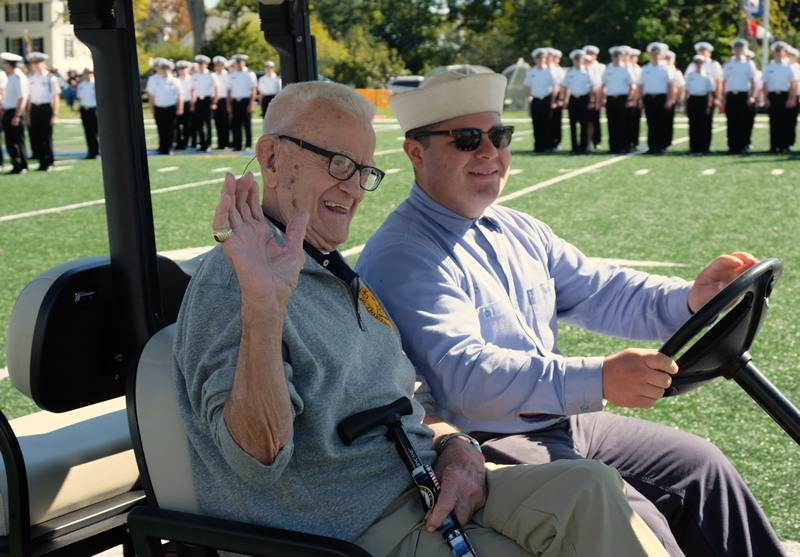
Gerald Rod Nelson ’43-2, the most senior alumnus to attend, has a smile for the crowd.
But all too soon the game was over, along with Homecoming until next year.
“It was incredible,” said Pete Mento ’93, who offered this salute: “Here’s to all our shipmates near and far. We hope you make your way back to the academy for our next one. I am intensely proud to have graduated from this amazing academy and so blessed to have sailed with the men and women who were there with me.”█
Photos: Billy R. Sims
HELLO!!More Than a Home Away from Home
At the home of Carol Adams and Rick Armstrong, as many as 20-25 Maine Maritime Academy students may show up for a special open house dinner.
“Every time I ask the kids, ‘What do you want to eat?’ they say, ‘Really good steak,’” Adams says with a laugh. “That’s our most well-attended event.”
A good home-cooked meal is just one of the benefits available to students through MMA’s Castine Sponsor program. Armstrong and Adams are long-time participants of the program, which pairs local families with one to two incoming students from out of state each fall.
The program provides new students, many far from home for the first time in their lives, with a substitute family, so to speak.
Sponsors are happy to introduce students to the area, invite them into their homes for meals, provide transportation to the airport at vacation time, bring students along on grocery runs, invite them for family activities such as sailing, fishing, or attending local events, or just allow them to hang out.
The relationships are available to the students throughout their time at MMA, so long-time sponsors might have 8 to 10 students on their roster.
“One thing about Maine Maritime—they have incredible resources to help students who are struggling in any kind of way, academic or otherwise,” says Armstrong. “We’re a little cog in that wheel, and we’re pleased to do it.”
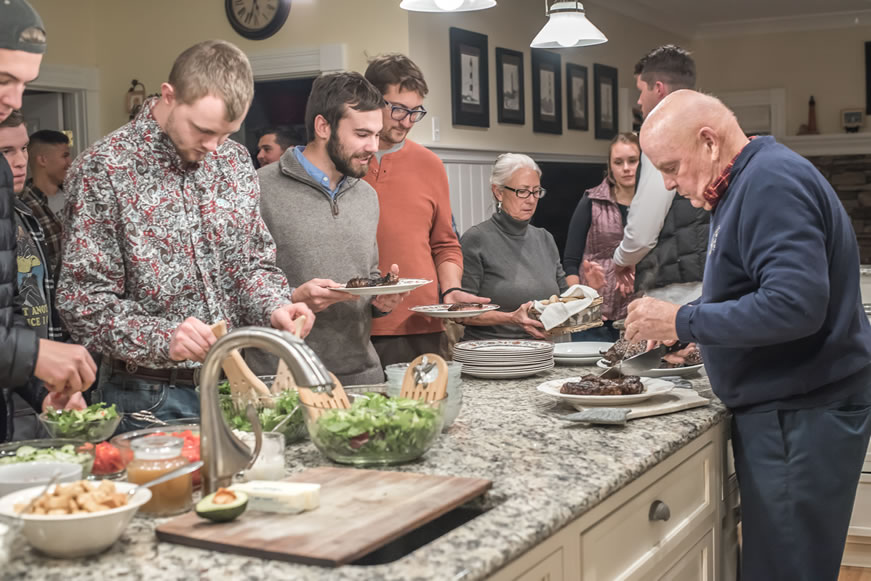
Adams and Armstrong sometimes host not only their sponsored students, but also other students for special meals.
Started by Jeff and Susie Loustaunau in 2001, about 20 families are involved in the program today. The Loustaunaus got the idea when their daughter and son attended the U.S. Naval Academy in Annapolis, Maryland, which has its own sponsor program.
“We saw real benefit in that and thought it could work here,” says Jeff. “These are kids far from home and in a very different environment, especially the students who are in the regiment. The idea is to give them something similar to a home where they can go and relax, maybe have a home-cooked meal.”
In addition, says Susie, “We thought it would be good for people in the community to have contact with students so they would get to know more about the school.”
Armstrong and Adams moved to Castine in 2008 for retirement. Armstrong connected with MMA through its tidal energy program, then became an adjunct professor of engineering. (Adams formerly worked in finance for a global company. Armstrong’s former positions include marine engineer, boatyard and marina owner/operator, and head of port security for the State of Massachusetts.) They learned of the program from the Loustaunaus and decided to give it a try in 2010.
“It was another dimension of getting involved with the students,” says Armstrong. “It’s one thing to see them in the classroom but another to get to know them in a more residential environment.”
Since then, they’ve become enthusiastic participants, “officially” hosting 16 to 20 students. “At any given time, officially, we have two students for each year for the five years,” says Adams. “But unofficially, we have quite a few more.”
“They always have friends, and we encourage that,” says Armstrong. “We have a good-sized boat shed, and there’s lots of stuff in there that I brought from the boatyard and from my hobbies. They really get engaged in that.”
Plus, they love to entertain. Fall weekends see students swarming the couple’s apple trees, plucking fruit and pressing it for cider. Sundays are pretty much open house with evening supper. Planned events include that steak dinner, plus a big cookout during Homecoming weekend and a lobster bake for graduation.
“By then, we know the students and their families pretty well,” says Adams. Generally, we have parents staying with us by that time.”
Matthew Breuer had Adams and Armstrong as his sponsor. “It felt like I was home every time I was over there,” he says.
Breuer, who is from Alton, New Hampshire, enrolled at MMA in 2013. Majoring in marine engineering technology, he graduated in 2017 and is now a U.S. Navy Civil Engineer Corps officer.
“They kind of adopted me and my friends. I’ll never forget the big party they threw for me, with a big, old-fashioned lobster bake, the day I graduated.”
Breuer recalled receiving an email from MMA before the start of his freshman year. “It says, ‘If anyone is interested in having a host family, please respond to this email,’” Breuer says. “It sounded interesting. Why not?”
A couple of weeks after arriving at school, he met Armstrong and Adams during a meet and greet. “After that, they started inviting me over for dinner,” he says.
Breuer found the couple was available for anything he might need.
“Rick would let me use his tools,” he says. “They would let me bring my friends over to hang out or watch football. They kind of adopted me and my friends. I’ll never forget the big party they threw for me, with a big, old-fashioned lobster bake, the day I graduated and was commissioned into the Navy.”
Some students look at the program in strictly practical terms—a ride to the airport or an overnight stay. But for most, the relationship becomes a form of support.
“It was really helpful,” says Edison Ma, a 2018 graduate in Marine Systems Engineering and now an engineer for the American Bureau of Shipping. Adams and Armstrong became Ma’s sponsor in his junior year. “It was a personal experience, to get to know them well, to have a place to get away from campus on weekends, and to have someone who lived close by and could help out just in case anything happened.”
Ma says it’s also a great way to connect with upperclassmen in a casual setting.
“Because there were two students per host family each year, we could get to know upperclassmen face-to-face and learn the nitty-gritty about how they got through cadet shipping and the training cruise and so on, and then turn around when new students came in and tell them how we got through it,” he says.
“It makes them feel they’re not alone, and there are people in the community who are looking for them to succeed, so they don’t feel like they’re the only ones in this,” says Rachael Iannoli.
Iannoli and her husband, Phil Cotoni, became sponsors after moving to the area five years ago, when Cotoni was offered the position of General Manager of Dining Services at MMA. Iannoli subsequently became MMA’s Conferences and Events Director. They became involved in the program right away because they figured it would be a great way to get to know students. Like Adams and Armstrong, they’ve had a dozen or so official students. “But, I’ve had a lot of step-sponsor kids, too,” Iannoli says. “I’ve probably had 10 to 15 kids at the house at a time.”
“Italian night” feasts are big at their house. And it’s just fun to be there.

Tynan O’Brien, Huxley Conner, Erik Brocken, Ahmed Al Shuwaili, Miles Schoenberg, Nate Arena, Will Scarlet, Caroline Foy, Shea Donnelly, Kealoha Higgins, Avery Leclerc, Will Guerette.
“We have dirt bikes and four-wheelers and lots of animals,” says Iannoli. “They come for dinner, or we take them to the doctor or pick them up from the airport or communicate with their families.”
For parents, the program can be reassuring and useful. Iannoli and Adams speak to occasional roles as touchstones for nervous parents.
Another strong sponsor has been Bev Bishop whose experiences with students sometimes has them attending symphony performances to broaden their cultural repertoire. “It’s a requirement,” she says. “I love my kids.”
The program fosters town-gown interaction, too. “Rick and Carol would always let me know when the locals needed help,” Breuer says.
“This host program gives many Castine residents the only way to connect with Maine Maritime,” says Armstrong. “We encourage people—they really ought to try it, at least for a year, to get an understanding of the program and the academy.”
Most poignant are the lasting friendships.
“They’re in touch all the time and invite us to changes of command and getting their wings and being part of their lives,” says Armstrong.
For more information about the program, visit mainemaritime.edu/student-life/campus-resources/castine-student-sponsor-program or contact Rhonda Varney at rhonda.varney@mma.edu.█
Photos: Rhonda Varney
Past & Present Sponsors:
- Rick Armstrong and Carol Adams
- Wallace and Alice Alston
- Terri Biggie
- Bev Bishop
- Pat Bishop
- Victoria and Temple Blackwood
- Bill and Heather Brennan
- Bill and Sylvia Carter
- Jean Cass
- Renee and Denny Colson
- Annegret Cukierski
- Karen and Chad Cukierski
- Craig and Katrina Dagan
- Ruth Eaton
- Bill and Kathy Eisenhardt
- Joyce and Jurgen Engelhardt
- Bob and Sam Freidlander
- Nathan and Tracy Gandy
- David and Bridgette Gardner
- Jimmy and Sue Goodson
- Bob Gross and Carol Cody
- Dave and Gordana Hassett
- Patrick and Lisa Haugen
- Rick and Kay Hightower
- Rachael Iannoli and Phil Cotoni
- Par and Gunilla Kettis
- Karen Koos
- Ted and Tracy Lameyer
- Cindra Leeman
- Jeff and Susie Loustaunau
- Christine Lutz
- Linda and Gordon MacArthur
- Mac and Kathy MacArthur
- Sue and Jack MacDonald
- Sue Macomber
- Michele and Joel Mann
- Kathy and Jayme Maynard
- Lynn Mosher
- Karen Motycka
- Bette Norris
- Mark and Dianna Payne
- Tony and Bonnie Politano
- Adam and Ellen Potter
- Mark and Kelly Sawyer
- Nancy and WG Sayre
- Bob and Pam Scott
- Don Small
- Jack and Christine Spratt
- Joanna Sweet
- Jeff and Valerie Taub
- Don and Marty Tenney
- Rhonda and Sean Varney
- Scott Vogell
- Dana and Cyndi Willis
Rowing with Heart
SATURDAY, SEPTEMBER 8
As crew members of the MMA rowing teams stood facing the waterfront of SUNY Maritime College, the scene couldn’t have been more different from the one they left behind in Castine.
To the west, the towering skyline of New York City. In the water, teams from SUNY, Massachusetts Maritime, U.S. Coast Guard, and U.S. Merchant Marine academies, practicing for races about to commence, coxswains shouting to their crews to quicken the pace.
The two MMA teams were all MUGs (Midshipmen Under Guidance), some of whom had never rowed before just two weeks earlier when they began training for the George C. Previll Memorial Inaugural Inter-Academy Monomoy Challenge.
There was one unspoken question in each of their minds.
WEDNESDAY, AUGUST 29
Lifeboat races between maritime academies were common in the 1950s and ’60s. But in recent years, none had been held, with the exception of an annual competition between Kings Point and SUNY Maritime, sponsored by the Marine Society of the City of New York. Members of the Society resolved to bring back the inter-academy races this year.
“When they contacted us,” says Dean of Maritime Training and Commandant Nathan Gandy ’92, “I looked at it as an opportunity for engagement with the other schools and said, ‘We’ll absolutely do it.’ Although I really didn’t know what ‘it’ was in the very beginning.”
The task of organizing and training MMA teams was given to Lieutenants Lonnie Christian and Kyle Willette, company officers for the regiment who put out the call for “motivated MUGs” to volunteer on Day 5 of RPT (regimental preparatory training).
Among them was Ethan Belesca, marine engineering technology major. “Initially, there were 40 MUGs who volunteered and were chosen to head down to the waterfront to see what we could do,” he says. “For the first few practices, there were four boats until we eventually narrowed it down to two.”
Lifeboat handling is a normal part of preparatory training: learning how to row and work as a team and following commands, which are described in The Maine Brace. “For many, it’s their first exposure to being on the water and on a boat with other crew members,” says Willette.
Different courses were charted along the waterfront, and as the teams solidified, so did the intensity of the effort. The strongest rowers and coxswains were identified “as we tried out what worked through trial and error,” says Willette. “We saw what worked for one boat, then we’d apply it to the others.”
Everyone was encouraged to make suggestions, and those with more experience, such as Kailyn Russell, a marine transportation operations major who had worked as a deck hand on the schooner Margaret Todd in Bar Harbor, had ideas.
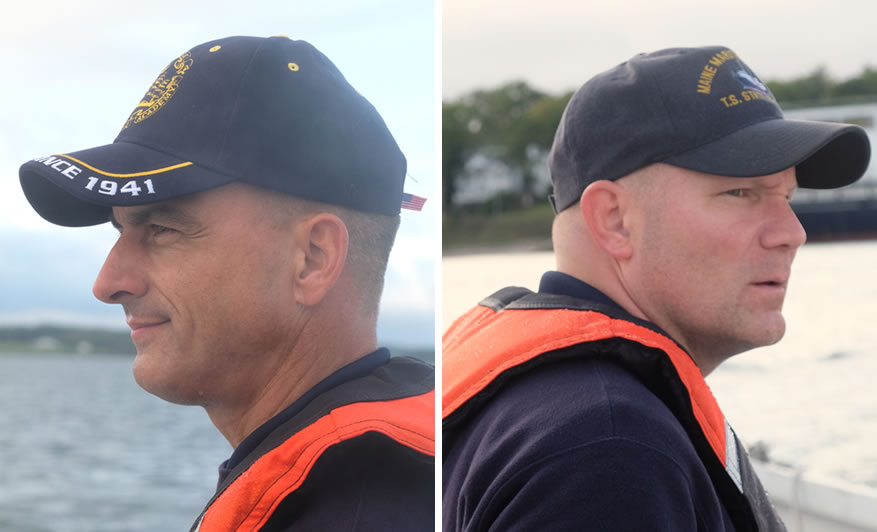
Company officers, Lieutenants Lonnie Christian and Kyle Willette led—and inspired—the teams.
“People were really receptive, and we’d try different things and if it worked, we would use them,” she says. “So that was cool.”
Forming relationships, learning from one another, problem-solving, developing communication skills, and watching leadership emerge were just some of the benefits that came from the two weeks of practice on the waterfront.
“And we did the physical work,” says Willette, “from rowing for stamina, control and sprints to using the full body for maximum power, stroke coordination, and technique.”
“As race day at SUNY approached, there were definitely a lot of things we needed to work on,” says Russell. “There was the excitement of racing against one another here at MMA, but we really had no idea how we were going to match up against the other teams, some of whom had been doing this for years.”
FRIDAY, SEPTEMBER 7
On the nine-hour bus ride from Castine to New York, the 28-member crew, of which 15 would compete as two boat crews and seamanship team, went over their strategy. The seamanship part of the competition would involve a timed rescue that required rowing to and retrieving a five-gallon bucket, which represented a man overboard; heaving one line for distance and another for accuracy; and a knot-tying relay.
The relay would demand each person in a six-member team tie a specified knot in turn for speed and correctness. This had not been thoroughly practiced in the run-up to the race, so as the bus rumbled south, the relay team worked on perfecting their bowlines, half-hitches, figure-eights and others with determination, challenged by occasional bumps in the road.
The story behind the victory.
RACE DAY
Saturday morning’s events commenced with open practice with Monomoy boats and oars provided by SUNY Maritime. As soon as they were on the water, the two MMA crews discovered the boats were lighter than those in Castine, and the oars were solid Shaw & Tenney ash that seemed to provide more direct transfer of power versus the carbon fiber ones they had been using.
“We noticed some of the other teams rowing, and they weren’t in sync the way we were,” says coxswain George Stamatopoulos, a marine transportation and operations major.
“In fact,” says Willette, “we saw many of them were struggling a little bit.”
It quickly became apparent that MMA might do well. “It buoyed confidence, and we could see it on the boat crews’ faces,” he says. “They were excited and knew they had a chance at this thing.”
After the annual rowing race of USMMA versus SUNY Maritime, won by SUNY, the main event began with a series of round-robin elimination races that had one boat from each academy running against another along parallel courses.
What these freshmen did was huge for us as a small school and small regiment…
MMA’s 10-member crew rowed to the start against Massachusetts Maritime and paused.
“As soon as the buzzer sounded we began to pull ahead,” says Stamatopoulous. “At that moment we knew we were going to do well. We finished several boat lengths ahead, and it really drove home that we were a team, we could make this work and come out on top.”
The next two boats facing MMA from the Coast Guard and Merchant Marine academies were also handily defeated, but in the heat against SUNY Maritime, the Mariners were defeated by a half-boat length.
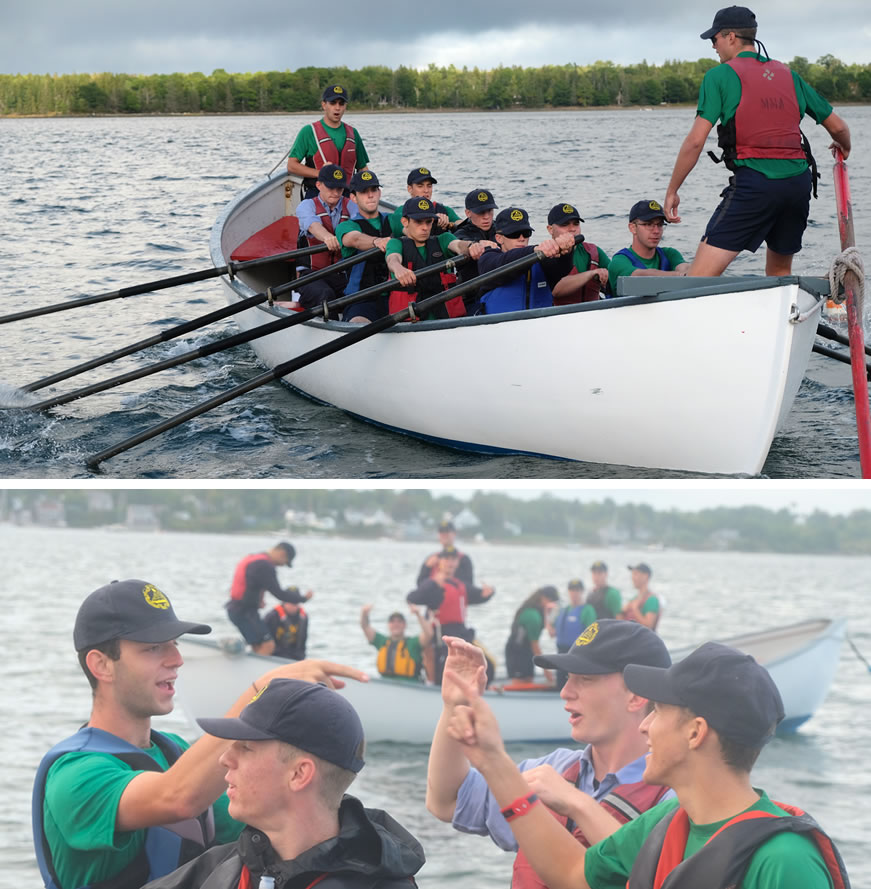
Getting it right on the water with intense practice yielded high-fives and a “most impressive” victory.
“Still, we had enough wins to make the final,” says Christian. “There was this great feeling among the crew of excitement and confidence.”
For the last round against SUNY, which crewed its boat with upperclassmen, MMA won the coin toss and chose the outside lane, where they had performed best earlier. The course was one-third of a mile straight to and around a buoy and back, adjacent to the SUNY training ship, with vessels of all makes and sizes traversing the channel just beyond the course.
When the start sounded, coxswain Stamatopoulos’ commands, “Stroke…stroke…stroke…” increased in tempo, and the boat pulled slightly ahead.
“If you were at the oars, it was time to just put your head down and simply row the boat,” says Belesca. “No matter what the hell happens, you just keep rowing with all you’ve got.”
Approaching the buoy for the turn back to the finish, Stamatopoulos leaned all of his body into the steering oar and initiated the turn. The starboard side rowers held their blades steady in the water, acting as a brake, while those on the port side applied all the torque they could muster, spinning the boat around the buoy and gaining yet more advantage on their opponents.
Perhaps sensing defeat or suffering fatigue, SUNY continued to fall behind as the MMA crew became focused on the finish and pulled away by more than a dozen boat lengths.
“Even as we went ahead,” says Russell, “there was no ‘We got this now.’ We leaned into it and tried absolutely as hard as we could until we crossed the finish line.”
Ashore, exuberant shouts and high-fives were exchanged by Willette, Christian, alternate crew, alumni and supporters (hosted by Alumni Relations.)
“I think Lieutenant Christian and I were more nervous than anyone in that boat,” says Willette. “We were so proud of them, and they realized they had pulled off something remarkable.”
SATURDAY AFTERNOON
The win gave MMA a morale boost in the ensuing seamanship competition. First came the line heave for accuracy, where MMA missed out on gaining points. But then came the line heave for distance, where MMA took second place.
Next, six members of the crew stood side by side in the knot-tying relay, and 1-2-3-4-5-6, they won.
Finally, the crew rowed some 200 meters to retrieve the “man overboard” bucket in the fastest time, which they won in spite of sizable wakes rolling in from the nearby ship channel.
The combined rowing and seamanship wins gave MMA a stunning victory, the George C. Previll Memorial Challenge plaque and $4,000 to be used for the regimental scholarship fund.
The competition and victory created their own rolling wake.

Six members of the crew stood side by side in the knot-tying relay and 1-2-3-4-5-6, they won.
“The net effect is that it brought all of the East Coast academies together,” says Gandy. “We’re different schools, but we’re entering the same industry and it’s small. We ought to be working across the board. This is a step in the right direction.”
In an email to MMA President Bill Brennan, MARAD Administrator, Rear Admiral Mark H. Buzby, USN, (Ret.) said, “Whenever your boat was in competition, there was a bone in her teeth and a frothy wake astern. Most impressive.”
Gandy notes, “While Lieutenants Willette and Christian were instrumental in overseeing the effort, the important thing is to recognize what this group of freshmen did, and that’s huge for us as a small school and small regiment to have that…call it bravado.
“The students did a lot of problem-solving, determining how to be effective, and took initiative.
“As has been noted, at Maine Maritime Academy you get a degree in ‘figuring it out.’ This win is a perfect example. Coming in the door, these students got a chance to figure it out and be successful,” says Gandy. “It’s such an intangible thing, but it’s so much of who we are as a school and a regiment.”
THE ANSWER
The unspoken question everyone had before the competition: Can we compete and do ourselves and the academy proud?
“Yes!” says Russell. “The biggest lesson I learned from the experience was shared by Lt. Christian. He told us, ‘The only way to row faster is to row faster. The only way to do better is to believe in yourself.’”█
Photos: Chris Cary, Billy Sims
MONOMOY MEMORIES
The Monomoy boat’s roots date back to boats used in the whaling industry and surfboats used by the U.S. Lifesaving Service, one of which was known as the Monomoy, designed for use in the high surf off Monomoy Island and Chatham, Massachusetts, according to this year’s race program brochure.
In 1934, the U.S. Coast Guard standardized the design for contract purposes, and thousands were built for use as lifeboats and gigs aboard naval and military ships, commercial freighters, and ocean liners. The standard Monomoy was 26 feet long, with a seven-foot beam.
In the 1950s and ’60s, Monomoy races between maritime academies were common. But subsequently, the races became fewer, and in recent years, none have been held.
“I remember the ’63 races in New York,” says Laurence Wade ’64, Commodore, USMS (Ret.). “Many of my MMA classmates were on the team, including John Chapman, Bob Pouch and Alan ‘Scotty’ Scott, as well as my brother, George.”
Says Wade, “I am happy to say I voted for the Portland Marine Society to be a sponsor for this year’s race,” which was presented by The Marine Society of the City of New York, whose partner sponsors included the Boston Marine Society and Portland Marine Society.
Among the shoreside supporters of the race was Capt. Robert “Bob” Pouch ’62, NYNM/USNR (Ret.), who entertained the MMA cadets with tales of when he and classmates were MUGs. They sometimes rowed to Smith Cove across from the Castine waterfront, where they were out of sight of their strykers and relaxed and played touch football. “Not a single day passes by without special memories of my days at MMA,” says Pouch, who has been an integral part of the New York Harbor administration and activities for many years.

A few pictures depicting the long history of Monomoy boats at MMA.
Current Affairs
Current Affairs
When Shipmate, the MMA alumni e-newsletter, recently put out a call for articles of interest to professionals, one of several suggestions had us hooked.
Into the Gulfstream by Pulitzer Prize-nominated writer Tony Bartelme chronicles how one of the mightiest currents on Earth is changing with potential devastating effects for the Atlantic Coast. “The race to understand the Gulf Stream is a deep dive into history, technology and recent aha moments in science.”
Whether your favorite reads come from gCaptain, ASME, or Marine Science Today, send us the message—preferably not in a bottle—and a url link to alumni@mma.edu, and we’ll share it.█
Perpetual Ocean by NASA
